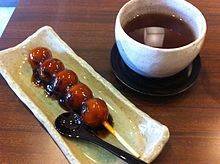- Mitarashi dango
-
Mitarashi dango (みたらし団子、御手洗団子) is a type of dango skewered onto sticks in groups of 3–5 (traditionally 5) and covered with a sweet soy sauce glaze. It is characterized by its glassy glaze and burnt fragrance.
Mitarashi dango originates from the Kamo Mitarashi Tea House in the Shimogamo area of Sakyo ward of Kyoto, Japan. Mitarashi dango is said to be named after the bubbles of the mitarashi (御手洗団子) (purifying water placed at the entrance of a shrine) of the Shimogamo shrine nearby. Another theory is that the 5-dango version sold at the original tea house was made to imitate a human body; the top-most dango represented the head, and the remaining four represented the arms and legs.
This dango is also sold in supermarkets and convenience stores in Japan. However, these versions of mitarashi dango have a relatively higher proportion of sugar to increase shelf life and are sweeter than those found at traditional tea houses and dango shops.
External links
American cuisine Latin AmericaAsian cuisine East AsiaChinese: Baozi · Ci fan tuan · Dim sum · Fun guo · Har gow · Hujiao bing · Jau gok · Jiaozi · Lo mai gai · Shengjian mantou · Shumai · Siopao · Suanla chaoshou · Tang bao · Tangyan · Taro dumpling · Wonton · Xiaolongbao · Zhaliang · Zongzi · Other: Akashiyaki · Buuz · Dango · Khuushuur · Mandu · Mandugwa · Manduguk · Mitarashi dango · MomoSouth East AsiaVietnamese: Ba-wan · Bánh bao · Bánh chưng · Bánh lá · Bánh tẻ · Bánh tét · Other: Caozai Guo · Kueh tutu · Kuih kochi · NagasariWest AsiaNorth AsiaEuropean cuisine Bryndzové halušky · Halušky · Kalduny (Kundumy) · Kopytka · Pierogi · Scovardă · Shlishkes · Strapačky · Uszka · VarenykySouthern EuropeCentral EuropeCapuns · Kluski · Knedle · Knödel · Maultasche · Mohnnudel · Pickert · Schupfnudel · Silesian dumplingsWestern EuropeNorthern EuropeOther AustraliaCategories:- Japanese cuisine
- Dumplings
Wikimedia Foundation. 2010.

